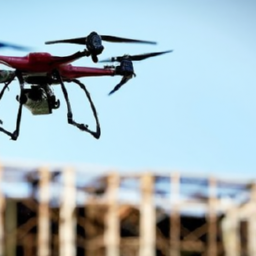Construction Industry Trends
In this article, we will explore the latest trends in the construction industry. From advancements in technology to sustainability practices, the construction industry is undergoing significant changes that are shaping the way projects are designed and executed. Whether it’s the adoption of Building Information Modeling (BIM) or the increasing focus on green initiatives, these trends are reshaping the future of construction. Let’s delve into these emerging trends and discover what lies ahead for the construction industry.
Table of Contents
Technological Advancements
Drones and Robotics
In recent years, the use of drones and robotics in the construction industry has revolutionized the way projects are planned, executed, and monitored. Drones equipped with high-resolution cameras can capture aerial images and videos of construction sites, providing valuable data that can be used for surveying, mapping, and site inspections. This technology allows for more accurate measurements, reduces the risk of human error, and improves overall project efficiency. Additionally, robots are being employed for various tasks such as bricklaying, concrete pouring, and even autonomous construction vehicles, reducing labor costs and increasing productivity.
Mobile Technology
With the increasing availability and affordability of smartphones and tablets, mobile technology has become an essential tool for construction professionals. Mobile apps and software solutions have been developed specifically for the industry, enabling better communication, collaboration, and project management. These apps allow workers to access project plans, blueprints, and schedules in real-time, regardless of their location. They also facilitate the documentation of work progress, quality control, and safety inspections. Mobile technology has streamlined many construction processes, saving time, minimizing errors, and improving overall project outcomes.
Building Information Modeling (BIM)
Building Information Modeling, or BIM, is a process that involves the creation and management of digital representations of physical and functional characteristics of a building. BIM allows for the integration of various aspects of a construction project, including design, cost estimation, scheduling, and facility management. It provides a comprehensive and collaborative platform that enhances communication, coordination, and decision-making among project stakeholders. With BIM, architects, engineers, contractors, and owners can visualize the entire project before construction begins, reducing the risk of errors and modifications during the construction phase.
Virtual Reality (VR) and Augmented Reality (AR)
Virtual Reality and Augmented Reality technologies are increasingly being used in the construction industry to improve design visualization, enhance communication, and optimize project planning. VR allows users to immerse themselves in a virtual environment to experience the final project design, identify potential issues, and make informed decisions. AR overlays digital information onto the physical world, enabling designers and contractors to see how different design elements fit within existing structures or landscapes. These technologies save time and money by identifying and resolving design conflicts early on, leading to more efficient construction processes and better project outcomes.
Sustainable Construction
Green Building Practices
As awareness of environmental issues continues to grow, the construction industry is embracing green building practices to minimize the environmental impact of projects. Green buildings are designed to be energy-efficient, water-efficient, and environmentally sustainable. They incorporate features such as solar panels, rainwater harvesting systems, and energy-efficient lighting and HVAC systems. These practices not only reduce the carbon footprint of buildings but also result in long-term cost savings through reduced energy and water consumption. Moreover, green building certifications have become increasingly popular, with projects striving to meet criteria such as LEED (Leadership in Energy and Environmental Design) certification.
Renewable Energy Integration
The integration of renewable energy sources, such as solar and wind power, into construction projects is another significant trend in sustainable construction. Renewable energy systems can be incorporated during the construction phase or incorporated into existing buildings through retrofits. Solar panels can be installed on rooftops or as standalone structures, providing clean and renewable energy to power the building’s electrical systems. Wind turbines can also be strategically placed on construction sites to generate electricity. By harnessing renewable energy, construction projects can reduce their reliance on conventional sources and contribute to a greener and more sustainable future.
Waste Reduction and Recycling
Efforts to minimize waste and promote recycling in the construction industry have gained momentum in recent years. Construction projects generate a significant amount of waste, including materials such as concrete, wood, metals, and plastics. By implementing waste reduction strategies and recycling practices, construction companies can minimize the environmental impact of their projects. Construction sites can set up recycling stations to separate different types of materials for proper recycling, ensuring that waste is diverted from landfills and reused in future projects. Additionally, sustainable construction practices can also involve the use of recycled materials and the adoption of circular economy principles.
Modular Construction
Off-Site Construction
Modular construction, also known as off-site construction, involves the manufacturing of building components in a controlled factory environment, away from the construction site. These components, or modules, are then transported to the site and assembled to create the final structure. Off-site construction offers numerous advantages, including reduced construction time, improved quality control, and minimized disruption to the surrounding environment. By manufacturing modules in an off-site facility, construction companies can streamline their processes and implement standardized construction techniques, resulting in faster project delivery and increased efficiency.
Prefabrication
Prefabrication is a key component of modular construction and involves the manufacturing of individual building components or systems off-site. These prefabricated elements, such as walls, floors, and roofs, are produced in a factory-controlled environment and then transported to the construction site for assembly. Prefabrication allows for greater precision, quality control, and efficiency compared to traditional on-site construction methods. It also reduces the amount of on-site labor required and improves safety by minimizing the risk of accidents and injuries. Moreover, prefabrication enables construction projects to be completed faster, resulting in cost savings and reduced overall project timelines.
Increased Efficiency and Cost Savings
One of the primary advantages of modular construction is its ability to improve project efficiency and generate cost savings. By manufacturing building components off-site, construction companies can optimize their production processes, enhance quality control, and reduce material waste. This streamlined approach allows for better coordination and sequencing of construction activities, leading to faster project completion. Additionally, off-site construction can significantly reduce on-site labor requirements, lowering labor costs and minimizing the reliance on skilled labor, which is becoming increasingly scarce. The overall result is improved project profitability, reduced construction timelines, and enhanced client satisfaction.
Focus on Safety
Emphasis on Preventative Measures
Safety has always been a top priority in the construction industry, and recent trends are focused on implementing preventative measures to minimize accidents and injuries. Construction companies are investing in safety training programs, promoting a culture of safety awareness, and implementing stricter safety protocols and procedures. This includes regular safety inspections, hazard assessments, and the use of personal protective equipment (PPE). By proactively addressing safety issues and identifying potential hazards, construction companies can create a safer working environment and protect the well-being of their workforce.
Implementation of Safety Management Systems
Safety management systems (SMS) are comprehensive frameworks designed to proactively manage safety in construction projects. These systems incorporate risk assessments, safety policies, and procedures to ensure that all construction activities are conducted in a safe and controlled manner. SMS also involve ongoing monitoring, measurement, and reporting of safety performance to identify areas for improvement and address any emerging safety concerns. By implementing SMS, construction companies can demonstrate their commitment to safety, comply with regulatory requirements, and effectively manage safety risks throughout the project lifecycle.
Training and Education
A skilled and well-trained workforce is essential for maintaining a safe construction industry. Construction companies are increasingly investing in training and education programs to enhance the knowledge and skills of their workers. This includes safety training courses, certifications, and ongoing professional development. By providing workers with the necessary knowledge and skills to identify and mitigate safety risks, construction companies can create a culture of safety and ensure that all workers actively participate in maintaining a safe working environment. Additionally, ongoing training and education programs help workers stay up to date with the latest safety regulations and best practices.
Increased Collaboration
Integrated Project Delivery (IPD)
Integrated Project Delivery (IPD) is a collaborative approach that involves early involvement and collaboration among all project stakeholders, including architects, engineers, contractors, and subcontractors. IPD promotes open communication, information sharing, and collective decision-making throughout the project lifecycle. By involving all stakeholders from the beginning, potential conflicts and issues can be identified and resolved early on, reducing the risk of delays and cost overruns. IPD also encourages the use of integrated technology platforms, such as BIM, to facilitate collaboration, data sharing, and coordination among project teams.
Building Information Modeling (BIM)
As mentioned earlier, Building Information Modeling (BIM) plays a crucial role in promoting collaboration in the construction industry. BIM facilitates the sharing of digital design information among project stakeholders, enabling better communication, coordination, and collaboration. BIM allows different disciplines to work together in a virtual environment, visualizing the entire project and making informed decisions. With BIM, architects, engineers, and contractors can detect and resolve clashes or conflicts between different design elements before construction begins, minimizing costly rework and ensuring constructability.
Collaborative Technologies
Advancements in technology have given rise to various collaborative tools and software solutions that enhance communication and collaboration in the construction industry. Cloud-based platforms allow project teams to securely store, access, and share documents and files in real-time, regardless of their physical location. Virtual meeting platforms enable stakeholders to collaborate remotely, reducing the need for frequent on-site visits. Mobile apps and software solutions facilitate instant communication, information sharing, and issue tracking. By leveraging collaborative technologies, construction projects can improve overall project coordination, accelerate decision-making, and enhance project outcomes.
Labor Shortages
Reduced Skilled Labor Availability
The construction industry is currently facing a significant labor shortage, particularly in skilled trades such as carpentry, electrical work, and plumbing. The aging workforce, coupled with a lack of interest among younger generations in pursuing careers in construction, has resulted in a shortage of skilled workers. This shortage poses challenges for construction companies, as they struggle to find qualified workers to meet project demands. To address this issue, companies are increasingly investing in workforce development programs, apprenticeships, and training initiatives to attract and retain skilled labor.
Higher Construction Wages
The shortage of skilled labor in the construction industry has led to increased competition for workers, driving up wages. Construction companies are facing higher labor costs as they strive to attract and retain skilled workers. Higher wages not only impact the bottom line of construction projects but also pose challenges for small or medium-sized contractors with tighter budgets. To address this issue, construction companies are exploring innovative solutions to increase labor productivity and reduce the reliance on manual labor, such as the adoption of automation and robotics.
Importance of Workforce Development
The labor shortages in the construction industry have highlighted the importance of workforce development and investing in the next generation of construction workers. Construction companies are collaborating with educational institutions, trade associations, and community organizations to promote careers in construction and offer training opportunities. Apprenticeship programs, vocational training, and mentoring initiatives are being implemented to attract and develop young talent. By investing in workforce development, the construction industry can address labor shortages and ensure a skilled workforce for future construction projects.
Digital Transformation
Internet of Things (IoT)
The Internet of Things (IoT) is transforming the construction industry by connecting physical devices and equipment to the internet, enabling remote monitoring, data collection, and analysis. IoT sensors can be embedded in various construction equipment and tools, allowing for real-time tracking of their performance, maintenance needs, and location. This data can be used to optimize equipment utilization, improve productivity, and reduce downtime. IoT also plays a crucial role in enhancing safety on construction sites, as sensors can detect hazardous conditions and alert workers to potential risks.
Big Data Analytics
The construction industry generates vast amounts of data throughout the project lifecycle, from design and planning to construction and facility management. Big Data analytics involves the collection, analysis, and interpretation of this data to extract valuable insights and make informed decisions. By analyzing historical project data, construction companies can identify patterns, trends, and correlations that can improve project planning, resource allocation, and risk management. Big Data analytics also enables real-time monitoring of project performance, allowing for proactive intervention and optimization of construction processes.
Cloud Computing
Cloud computing has revolutionized the way construction companies store, access, and manage data and software applications. Cloud-based platforms offer secure and scalable storage solutions, eliminating the need for on-site servers and infrastructure. This allows construction teams to access project information, drawings, and documents from anywhere, at any time, using any device. Cloud computing also enables real-time collaboration and information sharing among project stakeholders, regardless of their physical location. By leveraging cloud computing, construction companies can improve project efficiency, enhance collaboration, and reduce IT infrastructure costs.
Artificial Intelligence (AI)
The implementation of Artificial Intelligence (AI) in the construction industry is transforming how construction projects are planned, executed, and managed. AI algorithms can analyze large amounts of data to identify patterns, predict outcomes, and optimize various construction processes. For example, AI can help optimize construction schedules, resource allocation, and material procurement. AI-powered robotics and automation systems can perform repetitive or dangerous tasks with precision and efficiency, reducing the reliance on manual labor. AI also has the potential to enhance safety on construction sites by identifying potential risks and providing real-time alerts and recommendations.
Rise of Prefabrication
Streamlined Construction Processes
Prefabrication, as discussed earlier, streamlines construction processes by manufacturing building components off-site. The controlled environment of a factory allows for optimized production processes, better quality control, and increased efficiency. This streamlined approach minimizes errors, rework, and delays, resulting in faster project completion. By manufacturing components in advance, construction companies can also schedule assembly activities more efficiently, reducing on-site labor requirements and improving overall project coordination.
Improved Quality Control
Prefabricated building components undergo rigorous quality control checks in the factory environment, ensuring that they meet the required standards and specifications. By manufacturing components off-site, construction companies have greater control over the production process, enabling them to monitor and address quality issues in real-time. Prefabrication allows for the use of standardized construction techniques and materials, reducing the risk of inconsistencies or deviations in the final product. The improved quality control associated with prefabrication results in higher construction quality and client satisfaction.
Reduced Construction Time
One of the main advantages of prefabrication is its ability to significantly reduce construction time. By manufacturing building components in a factory-controlled environment, construction projects can progress concurrently. This parallel processing approach allows for faster project delivery, as on-site activities can commence while the components are being manufactured off-site. When the prefabricated components arrive at the construction site, they can be quickly assembled, minimizing construction time and reducing the overall project timeline. The reduction in construction time leads to cost savings and improved project efficiency.
Evolving Construction Materials
Use of Sustainable Materials
The construction industry is increasingly focusing on the use of sustainable materials to reduce its environmental impact. Sustainable materials are typically sourced from renewable sources, have low carbon footprints, and are recyclable or biodegradable. For example, sustainable wood, such as bamboo or responsibly sourced timber, is being used as an alternative to traditional lumber. Recycled materials, such as reclaimed bricks or recycled concrete, are also gaining popularity. Moreover, materials with high thermal efficiency, such as insulation made from recycled materials, are being used to improve energy efficiency in buildings.
Advanced Composite Materials
Advanced composite materials have opened up new possibilities in construction by offering enhanced strength, durability, and lightweight properties. These materials are typically made by combining different materials, such as fiberglass, carbon fiber, and resins, to create a composite with superior properties. Advanced composites are being used in various applications, including building facades, structural elements, and infrastructure projects. They offer advantages such as high tensile strength, resistance to corrosion, and the ability to be molded into complex shapes. The use of advanced composite materials in construction results in lighter structures, reduced material consumption, and improved structural performance.
3D Printed Construction
3D printing technology has gained significant traction in the construction industry, with the ability to quickly fabricate complex structures using various materials. 3D printed construction involves the use of automated machines that deposit layers of material to build up a complete structure. This technology offers numerous benefits, including reduced construction time, lower material waste, and increased design flexibility. 3D printing also allows for the creation of custom architectural features and intricate designs that would be challenging or time-consuming to achieve using traditional construction methods. As 3D printing technology continues to advance, its potential to revolutionize the construction industry is expanding.
Changing Consumer Expectations
Demand for Smart Homes
With the rise of smartphones, smart speakers, and other smart devices, consumers have come to expect connectivity and automation in every aspect of their lives, including their homes. Smart homes integrate various technologies, such as IoT devices, voice-controlled systems, and energy management systems, to provide homeowners with increased comfort, convenience, and energy efficiency. In the construction industry, there is a growing demand for smart home features, such as connected appliances, automated lighting and HVAC systems, and advanced security and surveillance systems. Builders are adapting to these changing consumer expectations by incorporating smart home technologies into their designs and offering customized smart home solutions.
Customization and Personalization
Consumers are increasingly seeking customized and personalized experiences, and the construction industry is no exception. Homebuyers and commercial property owners are looking for construction projects that can be tailored to their specific needs and preferences. This includes features such as open floor plans, flexible spaces, and customizable finishes and fixtures. Builders and developers are responding to this demand by offering more options for customization during the design and construction process. Advanced design software and visualization tools allow customers to see virtual representations of their future homes or buildings and make informed decisions about design elements and finishes.
Increased Awareness of Environmental Impact
There is a growing awareness among consumers about the environmental impact of construction projects and the importance of sustainable practices. Homebuyers and commercial property owners are placing increasing value on energy-efficient buildings, green building certifications, and environmentally-friendly materials and technologies. Construction companies that adopt sustainable construction practices and offer environmentally-conscious solutions are more likely to attract customers who prioritize sustainability. This includes incorporating features such as solar panels, rainwater harvesting systems, energy-efficient appliances, and sustainable materials into construction projects. The construction industry is responding to this demand by striving to meet sustainable building standards and certifications, such as LEED, and promoting environmentally-friendly practices.






